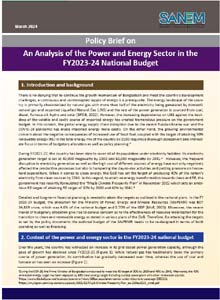Policy Brief on An Analysis of the Power and Energy Sector in the FY2023-24 National Budget
 Citation: Raihan, S., Bidisha, S. H., Ahmed, M. T., Hossain, I., Chowdhury, O. R., Asaduzzaman, M., & Surid, T. F. (2024). An Analysis of the Power and Energy Sector in the FY2023-24 National Budget. SANEM Publications, Dhaka, Bangladesh.
Citation: Raihan, S., Bidisha, S. H., Ahmed, M. T., Hossain, I., Chowdhury, O. R., Asaduzzaman, M., & Surid, T. F. (2024). An Analysis of the Power and Energy Sector in the FY2023-24 National Budget. SANEM Publications, Dhaka, Bangladesh.
There is no denying that to continue the growth momentum of Bangladesh and meet the country’s development challenges, a continuous and uninterrupted supply of energy is a prerequisite. The energy landscape of the country is primarily characterized by natural gas with more than half of the electricity being generated by domestic natural gas and imported Liquefied Natural Gas (LNG) and the rest of the power generation is sourced from coal, diesel, furnace oil, hydro and solar (BPDB, 2022). However, the increasing dependence on LNG against the backdrop of the volatile and costly source of imported energy has created tremendous pressure on the government budget. In this context, the global energy supply chain disruption due to the recent Russia-Ukraine war and the COVID-19 pandemic has made imported energy more costly. On the other hand, the growing environmental concern about the negative consequences of increased use of fossil fuel, coupled with the target of attaining 30% renewable energy (RE) in the total energy mix of the country by 2030 requires a thorough assessment and immediate focus in terms of budgetary allocation as well as policy planning.
During FY2021-22, the country has been able to cover all of its population under electricity facilities. Its electricity generation target is set at 40,000 megawatts by 2030 and 60,000 megawatts by 2041. However, the frequent disruption in electricity generation as well as the high cost of different sources of energy have not only negatively affected the production processes but also is hampering the day-to-day activities and putting pressure on household expenditure. When it comes to clean energy, the GoB has set the target of producing 40% of the nation’s electricity from clean sources by 2041. In this regard, to attain an energy transformation towards clean and RE, the government has recently formulated the “Mujib Climate Prosperity Plan” in November 2022 which sets an ambitious RE target of attaining RE target of 30% by 2030 and 40% by 2041.
Detailed and long-term financial planning is needed to attain the targets as outlined in the national plans. In the FY 2023-24 budget, the allocation for the Ministry of Power, Energy and Mineral Resources (MoPEMR) was BDT 34,819 crore, which was 4.6% of the national budget and 0.70% of the GDP (MoF, 2023). Moreover, the recent trends of budgetary allocation give rise to serious concern as to the effectiveness of resource mobilization for the transition to clean and renewable energy as stated in various plans of the GoB. Therefore, for attaining the targets as set by the policy documents the national budget of the MoPEMR needs to be re-designed in terms of both spending as well as financing.
